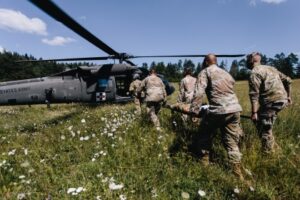Delayed Evacuation of Wounded Could Be an Issue

U.S. Army medic paratroopers assigned to the 173rd Airborne Brigade carry a “casualty” to a UH-60 Black Hawk during medical evacuation training in Grafenwoehr Training Area, Germany. The military is planning for future warfare where evacuation might be delayed. Photo by Spc. Ryan Lucas, 173rd Airborne Brigade
BETHESDA, MD — In planning and preparing for the future possibility of large-scale combat operations, military medicine might have to decide which wounded warriors can have delayed evacuations.
“The U.S. military is transitioning into a posture preparing for large-scale combat operations in which delays in evacuation may become common,” according to a new study in The Medicine Journal from the U.S. Army Office of the Surgeon General. “It remains unclear which casualty population can have their initial surgical interventions delayed, thus reducing the evacuation demands.”1
Researchers from the Uniformed Services University of the Health Sciences in Bethesda, MD, and Brooke Army Medical Center at JBSA Fort Sam Houston, TX, and colleagues performed a secondary analysis of a previously described dataset from the DoD Trauma Registry (DODTR) focused on casualties who received pre-hospital care.
The goal was to determine (1) of those who underwent operative intervention, the proportion of surgeries occurring three or more days post-injury, and (2) of those who underwent early vs. delayed surgery, the proportions who required blood products.
The focus was on 6,558 U.S. military casualties who underwent surgical intervention—6,224 of those early (less than three days from injury) and 333 delayed (more than three days from injury).
Results indicated that the median Injury Severity Score (ISS) was higher in the early cohort (10 versus 6, p is less than 0.001).
In the early cohort, the researchers determined that the most common were serious injuries to the:
- head (12% vs. 5%, p is less than 0.001),
- thorax (13% vs. 9%, p=0.041),
- abdomen (10% vs. 5%, p=0.001),
- extremities (37% vs. 14%, p is less than 0.001), and
- skin (4% vs. less than 1%, p=0.001).
“Survival to discharge was lower in the early cohort (97% vs. 100%, p is less than 0.001),” they advised.
The study also pointed out that mean whole blood consumption was higher in the early cohort (0.5 vs. 0 units, p is less than 0.001), as were packed red blood cells (6.3 vs. 0.5, p is less than 0.001), platelets (0.9 vs. 0, p is less than 0.001), and fresh frozen plasma (4.5 vs. 0.2, p is less than 0.001).
“The administration of any units of packed red blood cells and whole blood was higher for the early cohort (37% vs. 7%, p is less than 0.001), as was a ≥3 units threshold (30% vs. 3%, p is less than 0.001), and ≥10 units threshold (18% vs. 1%, p is less than 0.001),” according to the report.
The authors concluded that few combat casualties underwent delayed surgical interventions defined as three or more days post-injury, and only a small number of casualties with delayed surgical intervention received blood products, adding, “Casualties who received early surgical intervention were more likely to have higher injury severity scores and more likely to receive blood.”
Another study in the same journal looked at challenges as the U.S. military transitions from the Global War on Terrorism to prepare for near-peer combat in a multidomain operation (MDO) and/or large-scale combat operation (LSCO) setting.2
“Due to potentially contested freedom of movement in this setting, casualty evacuation may be significantly delayed, resulting in medics and other prehospital medical personnel taking on patient care duties normally performed by nurses in a hospital-based setting,” wrote the researchers from BAMC and USU. “However, the frequency of nursing-type care remains unclear.”
The study team sought to determine the nursing interventions typically performed in a facility with patient-holding capability during the first 72 hours of care in the deployed setting.
Their article is a sub-analysis of data from the DoD Trauma Registry of U.S. and North Atlantic Treaty Organization (NATO) military personnel from January 2007 to March 2020. The focus is on relevant nursing procedures identified in current Individual Critical Task Lists (ICTL) for critical care, emergency, medical-surgical nurses and combat medics.
The analysis advised that, among all casualties, the most common nursing-related skills performed in the prehospital setting were:
- wound dressing application (33%),
- administration of parenteral opioids (35%), and
- administration of ketamine (7%).
In the hospital setting, most common were:
- preparation for transfer (60%),
- managing a post-operative patient (59%), and
- managing a traumatic brain injury (44%).
“In the hospital setting, most patients had a blood gas performed (73%), ventilator management occurred for 21% of patients, and administration of packed red blood cells occurred for 21% of patients,” the authors added.
The articles concluded that nursing-type interventions were frequently required during the first 72 hours of casualty care. “The frequency of the required interventions demonstrates the need for ongoing nursing skills training for medics supporting casualties in the setting of prolonged casualty care,” the researchers wrote.
- Arnold JL, MacDonald AG, Baker JB, Rizzo JA, April MD, Schauer SG. An Assessment of Casualties Undergoing Delayed Surgical Intervention in the Combat Setting. Med J (Ft Sam Houst Tex). 2023 Jan-Mar;(Per 23-1/2/3):28-33. PMID: 36607295.
- Wilson KE, Vasek M, VanFosson CA, Flarity K, et. al. An Assessment of Nursing Skills Required for Sustaining a Casualty during Prolonged Casualty Care: Implications for Training and Preparing for the Next Major War. Med J (Ft Sam Houst Tex). 2022 Apr-Jun;Per 22-04-05-06(Per 22-04-05-06):83-88. PMID: 35373326.
